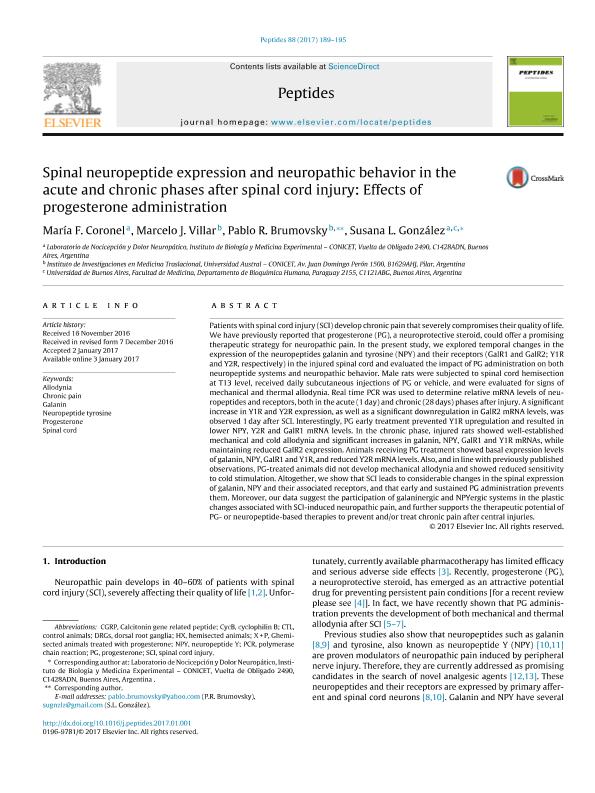Mostrar el registro sencillo del ítem
dc.contributor.author
Coronel, Maria Florencia

dc.contributor.author
Villar, Marcelo Jose

dc.contributor.author
Brumovsky, Pablo Rodolfo

dc.contributor.author
Gonzalez, Susana Laura

dc.date.available
2017-09-18T15:52:48Z
dc.date.issued
2017-01
dc.identifier.citation
Coronel, Maria Florencia; Villar, Marcelo Jose; Brumovsky, Pablo Rodolfo; Gonzalez, Susana Laura; Spinal neuropeptide expression and neuropathic behavior in the acute and chronic phases after spinal cord injury: effects of progesterone administration; Elsevier Science Inc; Peptides; 88; 1-2017; 189-195
dc.identifier.issn
0196-9781
dc.identifier.uri
http://hdl.handle.net/11336/24460
dc.description.abstract
Patients with spinal cord injury (SCI) develop chronic pain that severely compromises their quality of life. We have previously reported that progesterone (PG), a neuroprotective steroid, could offer a promising therapeutic strategy for neuropathic pain. In the present study, we explored temporal changes in the expression of the neuropeptides galanin and tyrosine (NPY) and their receptors (GalR1 and GalR2; Y1R and Y2R, respectively) in the injured spinal cord and evaluated the impact of PG administration on both neuropeptide systems and neuropathic behavior. Male rats were subjected to spinal cord hemisection at T13 level, received daily subcutaneous injections of PG or vehicle, and were evaluated for signs of mechanical and thermal allodynia. Real time PCR was used to determine relative mRNA levels of neuropeptides and receptors, both in the acute (1 day) and chronic (28 days) phases after injury. A significant increase in Y1R and Y2R expression, as well as a significant downregulation in GalR2 mRNA levels, was observed 1 day after SCI. Interestingly, PG early treatment prevented Y1R upregulation and resulted in lower NPY, Y2R and GalR1 mRNA levels. In the chronic phase, injured rats showed well-established mechanical and cold allodynia and significant increases in galanin, NPY, GalR1 and Y1R mRNAs, while maintaining reduced GalR2 expression. Animals receiving PG treatment showed basal expression levels of galanin, NPY, GalR1 and Y1R, and reduced Y2R mRNA levels. Also, and in line with previously published observations, PG-treated animals did not develop mechanical allodynia and showed reduced sensitivity to cold stimulation. Altogether, we show that SCI leads to considerable changes in the spinal expression of galanin, NPY and their associated receptors, and that early and sustained PG administration prevents them. Moreover, our data suggest the participation of galaninergic and NPYergic systems in the plastic changes associated with SCI-induced neuropathic pain, and further supports the therapeutic potential of PG- or neuropeptide-based therapies to prevent and/or treat chronic pain after central injuries.
dc.format
application/pdf
dc.language.iso
eng
dc.publisher
Elsevier Science Inc

dc.rights
info:eu-repo/semantics/openAccess
dc.rights.uri
https://creativecommons.org/licenses/by-nc-nd/2.5/ar/
dc.subject
Allodynia
dc.subject
Chronic Pain
dc.subject
Galanin
dc.subject
Neuropeptide Tyrosine
dc.subject
Progesterone
dc.subject
Spinal Cord
dc.subject.classification
Bioquímica y Biología Molecular

dc.subject.classification
Medicina Básica

dc.subject.classification
CIENCIAS MÉDICAS Y DE LA SALUD

dc.subject.classification
Neurociencias

dc.subject.classification
Medicina Básica

dc.subject.classification
CIENCIAS MÉDICAS Y DE LA SALUD

dc.title
Spinal neuropeptide expression and neuropathic behavior in the acute and chronic phases after spinal cord injury: effects of progesterone administration
dc.type
info:eu-repo/semantics/article
dc.type
info:ar-repo/semantics/artículo
dc.type
info:eu-repo/semantics/publishedVersion
dc.date.updated
2017-09-08T20:23:13Z
dc.identifier.eissn
873-5169
dc.journal.volume
88
dc.journal.pagination
189-195
dc.journal.pais
Estados Unidos

dc.journal.ciudad
Nueva York
dc.description.fil
Fil: Coronel, Maria Florencia. Consejo Nacional de Investigaciones Científicas y Técnicas. Instituto de Biología y Medicina Experimental. Fundación de Instituto de Biología y Medicina Experimental. Instituto de Biología y Medicina Experimental; Argentina
dc.description.fil
Fil: Villar, Marcelo Jose. Universidad Austral. Facultad de Ciencias Biomédicas. Instituto de Investigaciones en Medicina Traslacional. Consejo Nacional de Investigaciones Científicas y Técnicas. Oficina de Coordinación Administrativa Parque Centenario. Instituto de Investigaciones en Medicina Traslacional; Argentina
dc.description.fil
Fil: Brumovsky, Pablo Rodolfo. Universidad Austral. Facultad de Ciencias Biomédicas. Instituto de Investigaciones en Medicina Traslacional. Consejo Nacional de Investigaciones Científicas y Técnicas. Oficina de Coordinación Administrativa Parque Centenario. Instituto de Investigaciones en Medicina Traslacional; Argentina
dc.description.fil
Fil: Gonzalez, Susana Laura. Consejo Nacional de Investigaciones Científicas y Técnicas. Instituto de Biología y Medicina Experimental. Fundación de Instituto de Biología y Medicina Experimental. Instituto de Biología y Medicina Experimental; Argentina. Universidad de Buenos Aires. Facultad de Medicina. Departamento de Bioquímica Humana; Argentina
dc.journal.title
Peptides

dc.relation.alternativeid
info:eu-repo/semantics/altIdentifier/url/http://www.sciencedirect.com/science/article/pii/S0196978117300013
dc.relation.alternativeid
info:eu-repo/semantics/altIdentifier/doi/http://dx.doi.org/10.1016/j.peptides.2017.01.001
Archivos asociados
